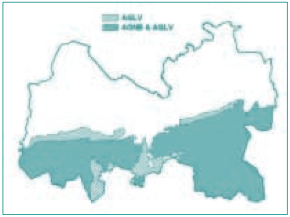 Abraham Lincoln
If given the truth, the people can be depended upon to meet any national crisis...
Abraham Lincoln
If given the truth, the people can be depended upon to meet any national crisis...
 Guildford news...
for Guildford people, brought to you by Guildford reporters - Guildford's own news service
Guildford news...
for Guildford people, brought to you by Guildford reporters - Guildford's own news service
Green Belt Around Guildford is Threatened Say Campaigners
Published on: 1 May, 2012
Updated on: 2 May, 2012

Green Belt Land just to the South of Guildford - The View to Chinthust Hill from The Hog's Back (Photo Lorimer Burn©)
Green Belt Countryside around Guildford and throughout Surrey is under threat from new waves of housebuilding despite the Government’s assurances, according to the Campaign for the Protection of Rural England (CPRE). Guildford is specifically mentioned in a list of towns where it has been recommended that some release of green belt land should occur.

Guildford Borough Green Belt - the only two areas that are not designated green belt within the borough boundary are Ash and Tongham on the left and Guildford Town in the centre
Members of the Surrey Branch of CPRE met and discussed the issue at their annual meeting last Friday (27 April) held at the Abraham Dixon Hall in Leatherhead. Members from all over the county attended the meeting where they heard speeches from leading countryside campaigners.
Speakers at the meeting highlighted the dangers they perceived to the Surrey countryside from growing development pressures and from the Government’s policy of promoting economic growth even at the expense of the environment.
Dame Sarah Goad, CPRE Surrey Branch President, said that England was getting more crowded and pressures on limited space were growing, making CPRE’s role more vital than ever.
Tim Murphy, the Surrey Branch Chairman, paid tribute to CPRE’s network of district groups, and said that local grass-roots action was essential in resisting unnecessary and inappropriate development.
He said that the Coalition Government’s changes to the planning system – the National Planning Policy Framework (NPPF) – had not been as bad as had been feared, but CPRE still had “grave concerns” about some aspects of the NPPF.
Surrey countryside must be protected and valued for its own sake, Tim Murphy said, whether or not it was in the Green Belt or the Area of Outstanding Natural Beauty (AONB). He went onto say that the NPPF, despite having been “watered down” from its original draft version, still contained the potentially dangerous “presumption in favour of sustainable development” which could be used by developers to justify new housing schemes.
Jack Straw, Planning Policy Manager of Mole Valley District Council, said that there were some important changes in the NPPF including the requirement that local councils considering planning applications should take into account the commercial viability of a development as well as other factors.
He also said that the NPPF had a strong commitment to high-quality building design, and that it made Local Plans “the heart of the planning system”. However, he was concerned about the extent to which Government policy was driven by “the economic growth agenda”.
Both Tim Murphy and Jack Straw said they felt the NPPF could lead to a lot of legal challenges and arguments.
Tim Harrold, Vice-President of CPRE Surrey and Chairman of CPRE’s Guildford group, explained that the Government at long last had declared gypsy and traveller sites to be “inappropriate development” for the Green Belt – but he had concerns about the nationally-imposed requirements for gypsy site provision and the problems that arise when local authorities are unable to meet these requirements.
The view of CPRE Surrey, he said, was that any new traveller sites should be on previously developed (“brownfield”) land in urban areas, and not in the countryside or rural areas.
The meeting also heard presentations from representatives from the Leith Hill Action Group about the campaign to stop drilling by an oil company at Bury Hill Wood near Coldharbour.
Recent Articles
- Notice: GTA Exchange Art Exhibition June 18-21
- Letter: I Would Rather Have Potholes Filled
- New Parish Councillor Says Funds from Developers Must Benefit the Local Community
- Tests at Paddling Pool Showed Water Was Too Alkaline, Says GBC
- Letter: Our Residents Want CIL Money Properly Used for Infrastructure Without Delay
- Charity’s New Programme Meets Needs of SEND Children Without School Places
- Pasta Evangelists to Open First Restaurant Outside London – Right Here in Guildford
- Police Seek Witnesses to Park Barn Assault
- Notice: Rosamund Community Garden
- Village School Set to Close Due to Falling Birth Rate


Search in Site
Media Gallery
Dragon Interview: Local Artist Leaves Her Mark At One of England’s Most Historic Buildings
January 21, 2023 / No Comment / Read MoreDragon Interview: Lib Dem Planning Chair: ‘Current Policy Doesn’t Work for Local People’
January 19, 2023 / No Comment / Read MoreA3 Tunnel in Guildford ‘Necessary’ for New Homes, Says Guildford’s MP
January 10, 2023 / No Comment / Read More‘Madness’ for London Road Scheme to Go Ahead Against ‘Huge Opposition’, Says SCC Leader
January 6, 2023 / No Comment / Read MoreCouncillor’s Son Starts Campaign for More Consultation on North Street Plan
December 30, 2022 / No Comment / Read MoreCounty Council Climbs Down Over London Road Works – Further ‘Engagement’ Period Announced
December 14, 2022 / No Comment / Read MoreDragon Interview: GBC Reaction to the Government’s Expected Decision to Relax Housing Targets
December 7, 2022 / No Comment / Read MoreHow Can Our Town Centre Businesses Recover? Watch the Shop Front Debate
May 18, 2020 / No Comment / Read More














Recent Comments